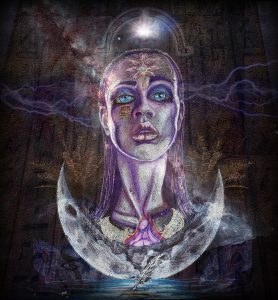
Seshat
Who is Seshat?
Was she just a lesser goddess, a bookworm, a scribe forever recording at the will of others?
Or did she have a more significant role that was overshadowed over time by other deities?
After discovering and getting to know Seshat, I am convinced she was a goddess of importance in her own right.
Seshat is an Egyptian goddess that has evolved over time. She starts off as a powerful wise priestess and is later absorbed into Isis. I think if you go back and find the significance of a deity before new waves of religion overtake and warp belief systems, there is magic to be found there.
Seshat had significant roles; she was the goddess of wisdom, words, measurement, mathematics, genealogy, record taking, divine architecture and history keeping.
She was the bridge between the two worlds of the spiritual and material; having a deep understanding and wisdom of how both above and below worked, she was able to mirror the world of man with the world of the gods. Although both Thoth and Isis get accredited for these roles in Egyptian mythology, Seshat had them first.
In my opinion, Seshat should have remained as she was, her stolen traits had more relevance and significance under her governance.
Although Thoth is credited for being the creator of language and writing, it was actually Seshat that invented the Hieroglyph and the word. In fact, all the subjects that she is responsible for she manifested. She creates with the bright spark of inspiration and understanding (a symbol above her head). Thoth, being gifted the knowledge, then translates and in turn gifts the divine knowledge to humanity.
What’s interesting here is that depending on what time period you look at, originally Seshat is Thoth’s wife. Later, she gets lowered to daughter, then to scribe, mostly absorbed by Isis. This slow phasing out of Seshat is due to transfers of power and different belief systems coming in and out of favour through the different dynasties of Egypt. Therefore, there seems to be debate about her status, because at different time periods in history she held different positions.
So if Seshat is originally Thoth’s wife, this puts a well-known Archetypal interpretation onto this idea.
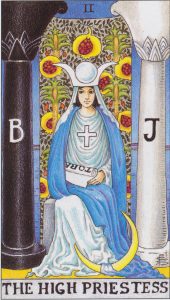
Rider Waite Smith High priestess
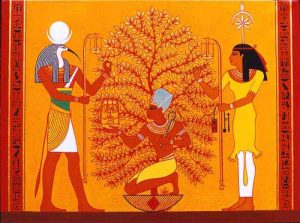
Thoth and Seshat with the tree of life
If there is any plausibility to the major arcana having originated in Egypt you can see the connection between The High Priestess and The Hierophant to the relationship between Seshat and Thoth.
Seshat, The High Priestess, is the bridge between two worlds; Thoth, The Hierophant, is the ‘messenger of the word,’ the teacher. In another sense, you could also relate these two to The Empress (the creator) and The Emperor (making order out of chaos.) Essentially this divine relationship that occurs throughout the ancient world is that of the female characteristics of the mind and soul, and the male aspects: left and right brain of consciousness.
The feminine principle represents feeling, intuition, receptivity, listening, understanding, creation, the ability to give birth, passivity, negative charge, south pole, cathode, chalice etc
The masculine represents doing, action, conduction, logic, instruction, modification and regulation, aggression, positive charge, north pole, spear/sword etc
There’s an interesting census graph that demonstrates this (all gender discussions, stigma issues and political incorrectness aside.) It shows how each role is currently represented as a gender fulfilled concept by society:
One example of gender power shift occured with the rewriting of history between Hatshepsut’s reign and Tuthmosis the III’s. There is much debate about what went on in this time period. My belief is that Tuthmosis did not hate his mother but was rather instructed by priests later on in his reign to tear down Hatshupsut’s walls. My reasoning for this is that Tuthmosis was not actually the son of the principle queen and so wasn’t true heir to the throne. The other reason is that neither of them tried to kill each other, they almost seemed to protect each other. Hatshupsut had Tuthmosis trained in all the arts of education and warfare. Not to mention, Tuthmosis gave Hatshupsut a proper burial and left her body un-desecrated, meaning she would live on forever in the afterlife. It seems that there was an urge to put gender roles in place after the 20 year reign of a female pharaoh. I think the priests were threatened, much like they were with Akhenaten. Note the priests were able to rewrite history by influencing the young Pharaoh Tutankhamen. I believe the same thing happened here, as the desecration on Hatshupsut carried on after Tuthmosis’s death, in the reign of his son.
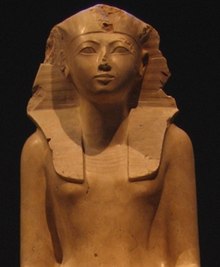
Statue of Queen Hatshepsut on display at the Metropolitan Museum of Art
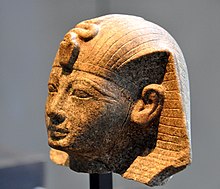
Head of Amenhotep II. 18th Dynasty, c. 1420 BC. 18th Dynasty. State Museum of Egyptian Art, Munich
By the end of Tuthmosis’s reign, Amenhotep II was regent and was known to start initialising the desecration of Hatshupsut. Also, Amenhotep had a weak claim to the throne, so wasn’t as concerned with recording the royal heritage, did not want the names of his queens recorded and in his reign, he also abolished much of the powerful titles and official roles of royal women; such as, ‘God’s Wife of Amun’. One theory that explains this is that he thought that his actions could persuade or inspire “future generations of potentially strong female kings to remain content with their traditional lot as wife, sister and eventual mother of a king” instead of assuming the crown.
So you can imagine this would affect the significance of Seshat’s role considerably. Not to mention the role of all female deities.
Isn’t it interesting that patriarchal religions are so quick to smite the relevance of women, even when the evidence of their vital order in the balance of life is everywhere to be found?
Also, that this same plight of gender eradication in history is still a constant battle to this very day, even in Egypt. Only now with the overthrowing of the Muslim Brotherhood affiliated president Hosni Mubarak and the sacking of Zahi Hawass are discoveries coming to light that are re-establishing the role of priestess and bringing forward ideas of feminine equality.
Despite character assassinations and demotion, Seshat still remains a household deity; after all she is still the recorder of time, lineage and spiritual/divine thought.
Let’s have a closer look at what it is Seshat does and represents.
Seshat’s main role is to record time and history and inscribe it into the eternal tree of life. When she is pictorialized this is the main activity she is depicted doing. Because she has an in-depth knowledge of the world, the universe and the otherworld, she is also the goddess of divine mathematics. Transferring the mathematics of the universe and replicating them on earth. These mathematics are quintessential to the design of all Egypt’s architecture. Resulting in Seshat being a well-respected goddess of all designers and trades people.
Once again Isis and Osiris are credited for sacred geometry but prior to the Hollywood couple of Egyptian deities, sacred geometry was Seshat’s scientific speciality.
Proof of this can be found in the drawing of the chord ceremony. This ceremony replicated Seshat measuring the stars and then creating a divine (golden) ratio. She would pull a chord and lay down the markers, creating the lay lines of which to build in line and likeness of the heavens above.
This method is still currently used in building today with the chalk chord.
This would have been fundamental in the early stages of Egyptian life, not just for megastructures but also for common folk. This method would have been used to measure crop sizes, to figure out whose land was whose, border lines, fence lines, boundaries etc. Keeping things in order.
As well as being a master architect/designer and mathematician, she was also above all a recorder of all aspects of life in Egypt. Interestingly, she is the only female deity depicted writing. The only other female characters depicted writing were sacred priestesses and scribes that were held in similar regard to Seshat. One famous queen being Nefertari.
People would appeal to Seshat (“She who opens the doors of heaven for you” Tuthmosis III) to record them into the history of the universe.
This is of tremendous importance, as in Egypt if you were not recorded and remembered you would cease to exist at all.
As well as recording life, she would also record granaries, spoils of war, wealth and legacies. No wonder patriarchal priests were so eager to relieve Seshat and the priestesses of their duties.
Seshat can also symbolise or mean seven. This is a reference to her link with harmony, music and the divine mathematics found within. She becomes the goddess of wave length. When you pull a chord, it vibrates and creates frequency and vibration. Frequency and rhythm are the corner stones of all life in the universe. Every life form, whether it be a heart or a star, pulses to a beat or a vibration. There are 7 harmonics of hearing, these seven harmonics create harmony to the ear; this in turn can be symbolised by the 7 heavenly bodies that rule the universe. Each of these create their own frequency. Some frequencies can affect your mood, whilst others can make water appear to move backwards, still others again can lift boulders. 7 is also the number of the major chakras in mystic teachings. 7 is the number of principal geographical directions; shadows are cast by the sun when using the sun to measure time and spacial area on the ground over a year tracking the solstices. The same principle as a sun dial. I read a fascinating article by Dusan Magdolen where he shows how by using the staff (Merkhet) ancient builders were able to create accurate measurements for building and mapping by tracking the suns shadow. Divine science… Seshat working her magic again.
Let’s look at other symbols of Seshat. She is depicted wearing a leopard skinned dress identifying her as a priestess. This is important as it sets her above being merely a scribe, as later suggested. She is a goddess with divine knowledge and sacred importance. She often has a staff made of a palm frond that is notched on one side (64 of) these look like teeth on a comb or saw, no doubt to measure, and this is held up against the tree of life. The tree representing the milky way, the universe, the abyss and the afterlife.
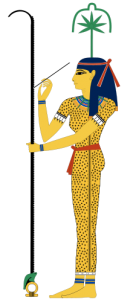
The symbol above her head
This is a category all of its own, as there are many interpretations of what this symbol actually means.
The Star/rosette: Some believe it is a star. It has 7 points. This makes sense as Seshat studies the celestial universe. Some say the star represents the 7 Hathors. This is representative of the different states of Hathor that would be present at the birth of a human being. Hathor also adopts the role of the eye of Ra or Horus, a protective symbol, a divine spark, consciousness. It has been suggested that the star also represents the birth of an idea or the conceptualisation of knowledge that Seshat the inventor creates. Mentioned before, Dusan Magdolen believes the symbol is a pictorial representation of the measurement systems Seshat bestowed on humanity. He provides sound reasoning for his theory. If you look at the images provided, the system used most certainly creates the symbol above her head on the ground.
http://www.academia.edu/3572586/A_NEW_INVESTIGATION_OF_THE_SYMBOL_OF_ANCIENT_EGYPTIAN_GODDESS_SESHAT
Others believe it is the actual tree of life or a palm leaf and others again believe it is the symbol of the marijuana leaf. This is solely based on traces of marijuana found in Ramses II tomb. Ramses II brings the importance of Seshat back and changes the star colour to green. However, claims that the star represents hallucinogens, to me, seem to be clutching at straws, as the plants referred to are so different to each other it would be unlikely one star could represent all of them. Also, not all of us need drugs to come up with great ideas!
The semi-circle above : Again much debate. The general consensus is that it is horns turned upside down. Horns typically represent the universe, the cradle in which the sun god lives. However, the Egyptians being as meticulous as they are surely would not just flip the script for aesthetic purposes. There are lots of theories for what the symbol means but not for why they should be horns.
The symbol could represent the goddess Nut (sky, universe.) Again Seshat maps the stars and reflects the world of above below. This also works as if her measurement system is based on tracking the sun; Nut is the sun’s mother. The sun runs along her body during the day and then re-enters her mouth to be reborn again the next morning. This actually ties in nicely with the Hathor star idea as not only would the 7 Hathor’s be present at the birth of the sun god, but Hathor herself takes the roles of Nut like Isis does to Seshat. The other reason this is a sound theory is that whenever Nut is drawn, she creates the upside down cradle shape and at night the light of the moon illuminates the earth. Seshat would also be recording the moon’s path as well. This ties into another theory that the shape is the precursor to the Omega.
Originally the Omega symbol was used to predict when an eclipse would occur. The symbol itself wasn’t referred to as ‘Omega’ but appeared the same and represented the lunar ascending nodes ( ½ path of the moon.) The symbol was flipped the other way to represent descending nodes (this does in fact look like the horns symbol.) There is one reference to Hathor having four horns each marking the cardinal points. The same symbol can be found in the libra symbol representing the September equinox, the point where the sun descends southwards (the time of Set), the end of the lineage, the end of Osiris’s reign.
Omega itself means ‘the end, end of the cycle of death and rebirth’. Interestingly the letter A, alpha originally represented the river of birth or creation. The waters from which all life came, like the Nile. Alpha and Omega are tied in an eternal cycle of death and rebirth, like the sun god being devoured and reborn from Nut. This idea leads to another theory that the symbol represents a vagina and the star the clitoris. An interesting article written by Nandani Felicia Bharrat voices the idea.
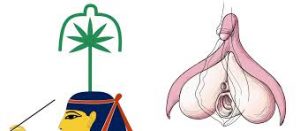
https://library.hrmtc.com/2017/04/17/seshat-and-the-clitoris/
Both Nut and Hathor represent the heavenly womb, with Hathor in particular; she hails the return of the Nile. In the Tarot, Hathor would be the Star; she replenishes the land with nourishment from her body. As she does when she rises from the destruction of Sekhmet.
Although this theory is controversial, if Seshat is a goddess of sacred priestesses and is also linked with Hathor, a goddess of birth and creation, it is not too much of a stretch to imagine feminine symbology being integrated into their iconography.
The symbol itself does lead to multiple other symbols of similar meaning. Firstly, the sign of the Vesica Pisces. This is two circles whose radius lay over each other in union. The shape makes the Pisces symbol, the fish. In early times (pre-christian) this symbol was always feminine. Even in relation to Jesus, he was referred to as the little sun born from within the fish. This relates to Isis and Osiris. When Set dismembers Osiris, Isis swallows his penis to impregnate herself; in some versions as the sacred fish Abtu. With the clitoral aspect of the theory – once the clitoris is stimulated, the vagina opens, like the pineal gland and the mind. The shape with the star also pictorially matches a diagram of the vaginal area.
This can be found when thinking of the omega symbol representing Ohm – sacred resonance- harmony of the earth. It also represents electrical resistance and the first depiction of the infinite number.
One article connected the two. The vagina creates electrical waves, these open and stimulate contraction; they also cultivate the activation of the orgasm.
This is electrical resistance, being the measure of current passing through a conductor. The act of friction to create vibration to stimulate an explosion that births light/life.
This is a very dry way to describe intercourse, but scientifically and spiritually, it is true.
An experiment that comes to mind is the ‘Star in a Jar’ where water (airtight) is contained in a spherical canister. Sound waves or vibration are continuously projected at it. At the centre an air bubble forms and explodes into light.
In the old world, sex, birth, fertility and the importance of the feminine were not taboo or rejected principles. They were equally important, as that of life and death. So it should be, as these subjects create life. Long before and much easier than science ever did. In fact it is more than likely that priestesses and wise women discovered science first, as they were the first to start tracking the moons cycles in correspondence to birth and period cycles, and this goes back to early human times.
With Seshat being the goddess of mathematics, architecture, sound, resonance and harmony, science, sacred priestesses, recorder of all things and also representing strongly the feminine aspect of these, I believe all these theories could be true. As with all religion, beliefs evolve with time.
One more theory I found interesting, and indeed this article is well worth reading, by David Warner Mathisen
http://mathisencorollary.blogspot.com/2016/10/the-goddess-seshat.html
This theory states that Seshat can be found in the heavens as the constellation of Ophiuchus. Ophiuchus is the snake holder, in his hands is a large double headed snake or twin snake. In esotericism, this is often symbolic of DNA or human biology. It also represents the two realms of existence. If you lay Seshat’s image over the constellation, you can see her holding a staff, recording on the tree of life (the milky way) and holding her sacred chord. I believe this is completely plausible. We know that ancient mystery schools were in Egypt and people from many cultures travelled to learn from the Egyptians and other mystery cults. Imagine if this is the pre-curser to the origins of the caduceus. Seshat is the recorder of life and death, this would include medicine and biology, which happen to be her husband Thoth’s specialities. Combine her sacred staff with the twin snakes of Ophiuchus and you have the caduceus. Above Seshat’s head you have the divine spark, the consciousness. This could be the origin of the eye above the caduceus as Hathor was sometimes represented as the Eye of Ra. This symbology could also be related to the Ankh, a symbol of life itself. Hathor also carries one of these. In his theory, David also suggests that the constellation above (typically Hercules) which is accredited to Thoth as well, looks as though he is reaching out to his wife. Husband and wife in the sky; she discovers and records, he is gifted with the knowledge and so gifts it to the world. This could be how Thoth/Hermes ends up with the caduceus originally. Of course, Isis eventually absorbs Seshat and gets to claim the right to the caduceus, as well as the connection to her husband in the great soap opera of Egyptian Deities… and like the sands of ancient Egypt these were the days of their lives… poor Seshat.
2 Responses
Vladmir
Hahaha “not all of us need drugs to come up with great ideas!”.
Feels like you feel offended because weed is sacred.
Also marijuana is not a hallucinogen
Si
HI Vlad,
I’m not offended by Marijuana being sacred. Not at all. I just don’t think the true origins of the symbol could be that plant. a later import.
After reading many articles, threads and posts, it became very clear that the drug element was undecided as the star went from being Marijuana to the Blue lotus,
to every other drug plant that could be found in the area. So if it is drug related wouldn’t it be a drug plant that had been around for nearly as long as the goddess herself?
Just a thought.
As you can see there are plenty of ideas as to what the star represents, if only we could truly know!